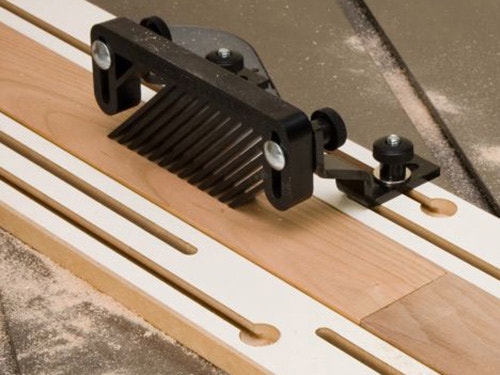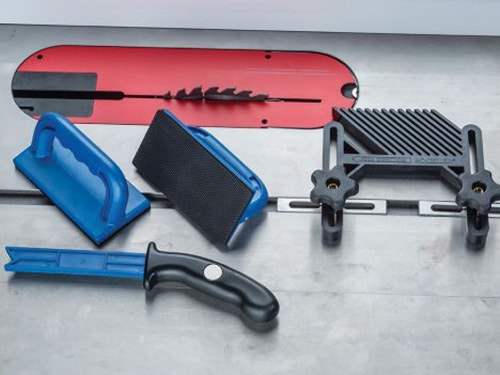Ten Table Saw Safety Tips
A table saw is a powerful piece of equipment, and deserving of respect. Learning how to use one correctly is the best way to stay out of trouble, and it's also the best way to get the most out of this valuable, versatile woodworking tool.
Here are ten simple things you can do to help promote safe and successful operation of the centerpiece of your shop.
1. Read the Instructions!
Where is your table saw owner's manual? In a drawer somewhere? If you haven't already, we strongly urge you to dig it out and familiarize yourself with the manufacturer's recommendations and precautions. Not everything that can get you into trouble using a table saw is obvious - but the manufacturer is very likely to warn you about the most important in the first few pages of the manual.
2. As With Any Tool, Use Appropriate Personal Safety Equipment.

You've heard it over and over again, and we'll say it once more: Always wear appropriate safety equipment and respiratory protection. It's an easy thing to neglect, especially when you're focused on your work. But please don't - we want you to enjoy a long, satisfying, injury-free woodworking career.
3. Keep Your Saw "Tuned Up."
Keeping you saw adjusted and in top running condition is one of the best ways to insure both your personal safety and the quality of your work. In fact, keeping your table saw aligned and running smooth is prerequisite for accurate, trouble-free operation.
4. Keep the Area Clean and Dust-Free.

Ignoring the dust and debris that builds up quickly around your saw is a sure-fire way to set yourself up for an accident. Get in the habit of picking up cut off pieces of wood right away, and establish a method of dealing with the mountains of dust and debris that accumulates so quickly around your saw. A broom and a dust pan are better than nothing, but a dust collection system is far better. A dust collection system will help keep your shop clean while you work, not after you've finished. And you'll be more likely to stay on top of the dust problem - its easier to flip a switch than to develop the habit of stopping work to clean up.
5. Keep Your Saw Blades Sharp - and Use the Right Type.
Using a dull, poor quality or inappropriate saw blade can do more than just compromise the quality of your work - it can turn your table saw into a menace.
6. Use Featherboards.

A featherboard's spring-like fingers hold the stock up tight against the surface of the table saw and the fence, providing a truer cut with less scoring and burning. Featherboards can help minimize the likelihood of kickback. The simple fact that the stock is compelled by the featherboard to follow a straight line means that there is less chance of the material binding between the blade and the fence and being propelled back toward the user. A featherboard is not a guarantee against kickback, but especially with shorter stock, it can help keep things running true and mishap-free.
7. Use Splitters and Blade Guards.
The safety equipment that came with your saw is there for a reason and provides valuable insurance against accidents. The splitter (or riving knife) is worthy of special mention. Located immediately behind the blade, it holds the saw kerf open and prevents the stock from closing in on the blade and binding. When it comes to preventing kickback, no single piece of equipment does more. Leave the one that came with your saw in place whenever possible. If you use a custom-made "zero clearance insert" (discussed below), equip it with a shop made splitter, or pick up an after-market solution.
8. Use Zero Clearance Inserts.
A zero clearance insert supports the stock right up to the edge of the blade for a cleaner cut, and prevents narrow pieces of drop-off form becoming wedged between the edge of the throat plate and the blade. Zero clearance inserts come ready-made for many saws, or you can make your own using a tough phenolic resin blank with Rockler's Phenolic Table Saw Insert Kit.
9. Use Push Sticks and Push Blocks.
With a table saw, a slip of the wrist or moment's inattention can result in a serious injury. Push sticks and push blocks keep your fingers at a safe distance from the blade. A basic push stick can be made fairly easily in the shop. Or, if you'd rather spend your time working on your projects, Rockler's Plastic Magnetic Push Stick makes a great store-bought choice. The plastic material won't damage an expensive blade if it accidentally comes in contact, and a magnet in the handle lets you keep it attached right to the side of your saw, close at hand when you need it.
10. Keep Learning.
With that, we've barely scratched the surface. There's much more. Table saw safety involves everything from your stance when you cut to a knowledge of the properties of wood to your frame of mind when you operate your saw. And because of that, the best table saw safety advice we can offer is this: make sure you understand the correct procedure for every cut you make before you make it. And then, keep learning.If you're new to using a table saw, consider taking a class or having an experienced woodworker show you the ropes. At the very least, arm yourself with as much reliable information as you can. There is a wide variety of books and DVDs out there. If you start off with a solid understanding of the basics, using your saw safely and correctly will soon become second nature.
Keep the inspiration coming!
Subscribe to our newsletter for more woodworking tips and tricks


